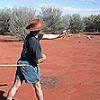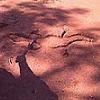Uluru
Northern Territory
"Ayers Rock, whose original Aboriginal name is Uluru, is the world's largest monolith, a big, red rock about 1,100 feet high and well over a mile long. It is considered sacred to the Anangu, the local Aboriginal tribe who now legally own and control it, though their ownership came with a long-term lease for its use as a park.
"Uluru is known for the incredible color changes the rock goes through at sunrise and sunset, as well as being a big rock in the middle of nothingness and a favorite climbing destination. This last is not cool with the Aboriginals; they have never climbed it and, since it is sacred, believe it should not be climbed. Further, they feel responsible for those that do climb and hold very emotional mourning rituals whenever a climber dies on the rock, which is distressingly often (though you will never read about it because it would be bad for tourism)." - Larry the O mlog
Many Ants
The Anangu word for the people who climb Uluru translates as "many ants." The reason for this name is obvious in the photo below right. The sing at left stands at the base of the rock, near the access point where the climb begins. Obviously, a lot of tourists ignore the Anangu people's request that they not climb the sacred rock.
Sacred Caves
The cave at left is Mala Puta, and it is sacred to women. We were allowed to photo it from here but forbidden to go closer. The cave at right contains the art in the center and right photos in the Cave Art section.
Cave Art
This cave art is tens of thousands of years old, and yet, in a manner of speaking, it is new. Traditionally, the peopple renew the pictures annually, but that tradition is fading.
 |
 |
|
Anangu Aboriginal Tour
"From there. however, things got more interesting, as we went to the Aboriginal Cultural Center owned and operated by the Anangu. Anangu Gours does not select their white employees in any traditional fashion: there are no job applications, no resumes, no tour guide experience is needed. In fact, it seems that they generally recruit people who have been around them for a year or more.
"Tony [our driver and guide in the early morning] became a sort of 'assistant tour guide' from the time we reached the cultural center. Our tour guides from that point were a tag team: Senior Aboriginal Guide Sammy Wilson (his English name), one of the company's owners and a quite remarkable man, and Katia, a white woman who acted as his interpreter. Sammy explained that we were on his land as his guests and, as such, he chose to speak his language, the language of that land. Katia had been studying and generally hanging around the Anangu and learning their language whne they completely freaked her out by asking her to be an interpreter. She felt wholly inadequate to the task, but they wanted her eloquence in English and told her to have faith and they would train her.
"Of course, she became a superb interpreter, more than a translator, since she tries to capture the poetry of how Sammy speaks. Sammy is a leader of the his tribe, as was his father and his father's father. In fact, his Aboriginal family name is Uluru, so he is quite literally Mr. Uluru. To once again point out how recent development of European settlement has been, Sammy's grandfather was one of the tribal leaders at the time of first contact with whites.
"Sammy himself, in his youth, was known for stunts like hunting kangaroo by chasing it on a motorbike, grabbing it by the tail, flipping it over (in the Red Center, you find red kangaroos that can grow up to eight feet tall), and then killing it with a single strike of a club. He was known to do this on multiple occasions. On the day we were with him, he demonstrated spear throwing so accurate that he twice came within inches of hitting a stick in the ground thirty feet away. Had it been anything larger than a mouse, it would have been dead. Very impressive." - Larry the O mlog
Sammy and Katia
Anangu Tools
"Sammy and Katia walked us out toward Uluru and taught us about the tools used by the Anangu, including how they were made and how they were used, both the men's and women's tools. He demonstrated and let us try spear throwing, then walked us to a choice spot in the shadow of Uluru and talked about his tribe's relationship with Uluru, why they don't want people climbing (they feel that those that come, climb the rock, and leave witout even understanding its meaning to the Anangu are missing the point of its existence), and gave just a small taste (a child's fable, essentially) of tjukurpa: the cultural definition/law/lore that defines their lives. It was an experience entirely unlike any I've known, very deep and with people (both Sammy and Katia) whose presence was strongly inspirational. And all of this was before 10 a.m.!" - Larry the O mlog
In the photo at left, men's tools are to the left, women's to the right. Sammy's hand is on the club, a heavy weapon that can kill with a blow. The black substance at the end, also used to repair the bowl (right), is called piti, and Sammy showed us how to make it. The photo at center shows a belt made of human hair. At right, Larry is once again trying his hand at throwing a spear. He did better this time than he did at Tjakupai!
Anangu Women's Carrying Bowls
Anangu women carry loads in wooden bowls on their heads, using the human-hair pads (left). At center and right, a German tourist practices proper carrying technique. That's Sammy with the tourist at right, and Larry is in the background of the center photo.
The Mudmap
Tjukurpa is at once the Anangu's religion, their law, their origin stories, and their way of life, all expressed through storytelling and taught using maps drawn in the mud. The story of Uluru is told in this mudmap, and Sammy read us the story as he would to children. In the photo at upper right (L-R): Sammy, Katia, and Tony.
The Blue-Tongued Lizard Man is a key actor in the Uluru story. The cave from which he fell to his death is located at upper right.
Termite Mounds
Termites are everywhere and build gigantic mounds, which you can see from the road in places. This is a small termite colony.

























